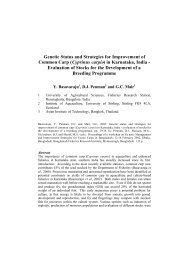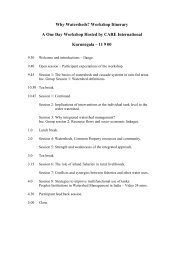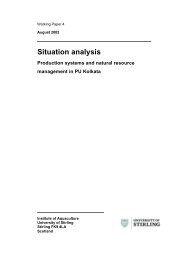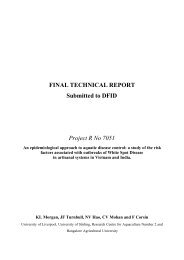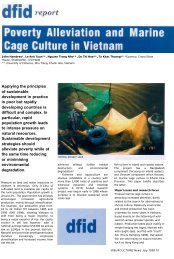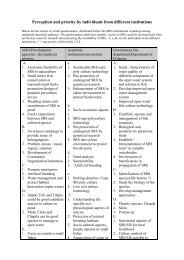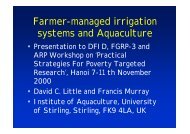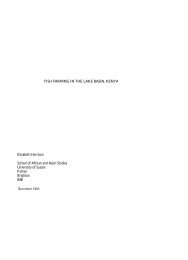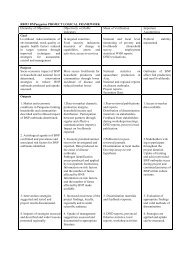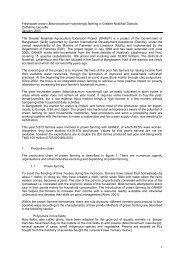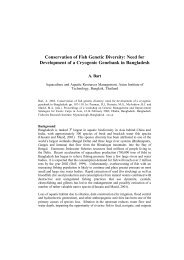Epizootic Ulcerative Syndrome (EUS) Technical Handbook
Epizootic Ulcerative Syndrome (EUS) Technical Handbook
Epizootic Ulcerative Syndrome (EUS) Technical Handbook
You also want an ePaper? Increase the reach of your titles
YUMPU automatically turns print PDFs into web optimized ePapers that Google loves.
Socio-economicsThe most severe impact of <strong>EUS</strong> has probably been on small-scale, mixedspeciesfisheries and aquaculture activities in rice-fields and rural waterways.It is estimated that 250 million families in the Asian-Pacific region dependon rice as a main crop and much of the incidental fish harvests from thesepaddies are an important part of the families’ diet (Macintosh, 1986). It shouldbe noted that the chief months for harvesting rice paddy fish are fromSeptember to February, the period when most ulcerative disease episodesoccur. In these circumstances, any figure on the financial cost of <strong>EUS</strong> mayunderestimate the full impact of the disease to these communities.Estimates of the economic value of fish losses to commercial fish traders aregiven in Table 2. These figures do not, however, take into account indirectsocio-economic costs due to market rejection of harvested ulcerated fish, orin some cases, even unaffected fish. In the 1980s, in some communities, awidespread, but unfounded, fear of disease transmission to consumers led toa drastic decrease in market demand for all food fish. Confidence in freshwaterfish farming, particularly among potential investors and financial agencies,was badly affected.In the Philippines, the average daily income of fishers (approximately US$4)declined to US$1.50 during disease outbreaks in Laguna de Bay due to therejection of affected fish (ADB/NACA, 1991). Bangladesh suffered severelosses from <strong>EUS</strong> in 1988 and 1989, and extensive local media coverage aboutthe disease fuelled the public’s fear of health risks from fish consumption,resulting in initial price reductions of up to 75% and high losses to fishtraders. Nepal has no marine fish resources and therefore relies heavily on<strong>EUS</strong>-susceptible species. It was reported that 15-20% of total fish productionwas lost in Nepal during initial <strong>EUS</strong> outbreaks (ADB/NACA, 1991). Theoccurrence of <strong>EUS</strong> in cultured major carp fingerlings gave rise to fears of apotentially crippling effect on the expansion of carp culture in the subcontinentregion. Bhaumik et al. (1991) reported that 73% of the culture ponds in WestBengal were affected at that time, and most of these were reported to have lostbetween 30-40% of their stock. In their report giving details of losses to inlandfishworkers in Kerala, the ICSF (1992) quote the official figure of Rs 20million, but commented that newspapers reported losses up to ten times thisfigure.The <strong>EUS</strong> pandemic has demonstrated to national authorities the ability offish disease to cause major financial losses, and as a result, one positiveimpact of <strong>EUS</strong> has been the increased funding allocated to fish diseaseresearch and diagnostic facilities in Asia by governments and internationalorganisations.13




